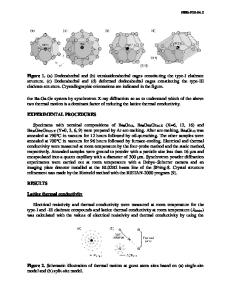Magnetic Structure and Thermal Expansion of Eu 4 Ga 8 Ge 16
- PDF / 434,202 Bytes
- 6 Pages / 612 x 792 pts (letter) Page_size
- 50 Downloads / 364 Views
DD10.2.1
Magnetic Structure and Thermal Expansion of Eu4Ga8Ge16 Henrik Birkedal, J. Daniel Bryan, Galen. D. Stucky, Mogens Christensen1 and Bo B. Iversen1 Department of Chemistry and Biochemistry, University of California, Santa Barbara, CA 93106, USA. 1 Department of Chemistry, University of Aarhus, Langelandsgade 140, 8000 Århus C, Denmark. ABSTRACT The orthorhombic clathrate compound Eu4Ga8Ge16 orders antiferromagnetically at about 8 K. The magnetic structure is established by neutron powder diffraction while the thermal expansion and atomic displacement parameters are studied by synchrotron powder diffraction. The Eu spins align along the a-axis and achieve a zero-temperature magnetic moment equivalent to that of the free Eu2+ ion. The thermal expansion is largest along the a-axis while the expansion along c has almost the same magnitude as that along b. The Eu displacement parameters display significant residual values at 0 K, largest in the c direction.
INTRODUCTION There has recently been a renewed and strong interest in inorganic clathrate materials. This is largely because they have been put forth as good candidates for phonon-glass electron-crystal behavior [1,2]. Their transport properties depend heavily on the exact stoichiometry and behavior ranging from semiconducting even to superconducting [3]. As part of our program (see [2,4-7] and references therein) in thermoelectrics, we recently reported the synthesis of a new clathrate structure: Eu4Ga8Ge16 [4]. This compound crystallizes in space group Cmcm, see Figure 1. It is a poor metal in that it has a low conductivity with metal-like temperature dependence. The Seebeck coefficient was found to be positive indicating that the carriers are holes. During our present investigations [6,7], another synthesis of the title compound was reported using near stoichiometric melts [8] leading to impure samples with Eu4Ga8Ge16 as the majority phase. Working on powder ingots, these authors also found a low, metal-like conductivity and an antiferromagnetic ordering transition at about 9 K. Using Hall measurements, they found
Figure 1. Crystal structure of Eu4Ga8Ge16.
DD10.2.2
negative carriers at room temperature. This apparent disagreement with our previous results [4] is most likely due to a different doping regime caused by slight variations in composition. Here we report a temperature dependent synchrotron powder diffraction study of the thermal expansion and atomic displacement parameters of the title compound. In addition, we find that the structure orders antiferromagnetically at ~8 K and the magnetic structure is elucidated using neutron powder diffraction.
EXPERIMENTAL DETAILS Eu4Ga8Ge16 was synthesized using the Ga-flux method previously reported [4]. In order to minimize problems with neutron absorption, a sample enriched in 153Eu was used in all diffraction data collections, both using neutrons and synchrotron radiation. Due to the very high cost of the enriched material, we could not remove all the remaining Ge (the Ga flux is easily removed by wash
Data Loading...











